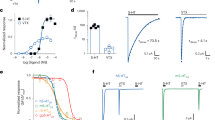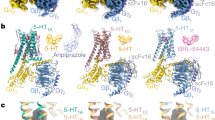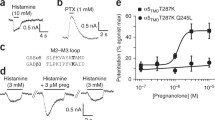Abstract
1. We have examined the interaction of tertiary amine local anesthetics with the bovine hippocampal serotonin1A (5-HT1A) receptor, an important member of the G-protein- coupled receptor superfamily.
2. The local anesthetics inhibit specific agonist and antagonist binding to the 5-HT1A receptor at a clinically relevant concentration range of the anesthetics. This is accompanied by a concomitant reduction in the binding affinity of the 5-HT1A receptor to the agonist. Interestingly, the extent of G-protein coupling of the receptor is reduced in the presence of the local anesthetics.
3. Fluorescence polarization measurements using depth-dependent fluorescent probes show that procaine and lidocaine do not show any significant change in membrane fluidity. On the other hand, tetracaine and dibucaine were found to alter fluidity of the membrane as indicated by a fluorescent probe which monitors the headgroup region of the membrane.
4. The local anesthetics showed inhibition of agonist binding to the 5-HT1A receptor in membranes depleted of cholesterol more or less to the same extent as that of control membranes in all cases. This suggests that the inhibition in ligand binding to the 5-HT1A receptor brought about by local anesthetics is independent of the membrane cholesterol content.
5. Our results on the effects of the local anesthetics on the ligand binding and G-protein coupling of the 5-HT1A receptor support the possibility that G-protein-coupled receptors could be involved in the action of local anesthetics.
Similar content being viewed by others
REFERENCES
Abrams, F. S., and London, E. (1993). Extension of the parallax analysis of membrane penetration depth to the polar region of model membranes: Use of fluorescence quenching by a spin-label attached to the phospholipid polar headgroup. Biochemistry 32:10826-10831.
Albert, P. R., Zhou, Q.-Y., Van Tol, H. H. M., Bunzow, J. R., and Civelli, O. (1990). Cloning, functional expression, and mRNA tissue distribution of the rat 5-hydroxytryptamine1A receptor gene. J. Biol. Chem. 265:5825-5832.
Arias, H. R. (1999). Role of local anesthetics on both cholinergic and serotonergic ionotropic receptors. Neurosci. Biobehav. Rev. 23:817-843.
Bikker, J. A., Trumpp-Kallmeyer, S., and Humblet, C. (1998). G-protein coupled receptors: Models, mutagenesis, and drug design. J. Med. Chem. 41:2911-2927.
Bligh, E. G., and Dyer, W. J. (1959). A rapid method of total lipid extraction and purification. Can. J. Biochem. Physiol. 37:911-917.
Bruns, R. F., Lawson-Wendling, K., and Pugsley, T. A. (1983). A rapid filtration assay for soluble receptors using polyethylenimine-treated filters. Anal. Biochem. 132:74-81.
Chattopadhyay, A., and Harikumar, K. G. (1996). Dependence of critical micelle concentration of a zwitterionic detergent on ionic strength: Implications in receptor solubilization. FEBS Lett. 391:199-202.
Chattopadhyay, A., Harikumar, K. G., and Kalipatnapu, S. (2002). Solubilization of high affinity G-protein-coupled serotonin1A receptors from bovine hippocampus using pre-micellar CHAPS at low concentration. Mol. Membr. Biol. 19:211-220.
Chattopadhyay, A., Jafurulla, Md., and Kalipatnapu, S. (2004). Solubilization of serotonin1A receptors heterologously expressed in chinese hamster ovary cells. Cell. Mol. Neurobiol. 24:293-300.
Chattopadhyay, A., and London, E. (1984). Fluorimetric determination of critical micelle concentration avoiding interference from detergent charge. Anal. Biochem. 139:408-412.
Chattopadhyay, A., and London, E. (1987). Parallax method for direct measurement of membrane penetration depth utilizing fluorescence quenching by spin-labeled phospholipids. Biochemistry 26:39-45.
Chen, R. F., and Bowman, R. L. (1965). Fluorescence polarization: Measurement with ultraviolet-polarizing filters in a spectrophotofluorometer. Science 147:729-732.
De Paula, E., and Schreier, S. (1995). Use of a novel method for determination of partition coefficients to compare the effect of local anesthetics on membrane structure. Biochim. Biophys. Acta 1240:25-33.
De Paula, E., and Schreier, S. (1996). Molecular and physicochemical aspects of local anesthetic-membrane interaction. Braz. J. Med. Biol. Res. 29:877-894.
Emerit, M. B., El Mestikawy, S., Gozlan, H., Rouot, B., and Hamon, M. (1990). Physical evidence of the coupling of solubilized 5-HT1A binding sites with G regulatory proteins. Biochem. Pharmacol. 39:7-18.
Fargin, A., Raymond, J. R., Lohse, M. J., Kobilka, B. K., Caron, M. G., and Lefkowitz, R. J. (1988). The genomic clone G-21 which resembles a β-adrenergic receptor sequence encodes the 5-HT1A receptor. Nature 335:358-360.
Franks, N. P., and Lieb, W. R. (1997). Anesthetics set their sites on ion channels. Nature 389:334-335.
Gimpl, G., Burger, K., and Fahrenholz, F. (1997). Cholesterol as modulator of receptor function. Biochemistry 36:10959-10974.
Gozlan, H., El Mestikawy, S., Pichat, L., Glowinski, J., and Hamon, M. (1983). Identification of presynaptic serotonin autoreceptors using a new ligand: 3H-PAT. Nature 305:140-142.
Gutierrez-Merino, C., Molina, A., Escudero, B., Diez, A., and Laynez, J. (1989). Interaction of the local anesthetics dibucaine and tetracaine with sarcoplasmic reticulum membranes. Differential scanning calorimetry and fluorescence studies. Biochemistry 28:3398-3406.
Harikumar, K. G., and Chattopadhyay, A. (1998a). Metal ion and guanine nucleotide modulations of agonist interaction in G-protein-coupled serotonin1A receptors from bovine hippocampus. Cell. Mol. Neurobiol. 18:535-553.
Harikumar, K. G., and Chattopadhyay, A. (1998b). Modulation of agonist and antagonist interactions in serotonin1A receptors by alcohols. FEBS Lett. 438:96-100.
Harikumar, K. G., and Chattopadhyay, A. (1999). Differential discrimination of G-protein coupling of serotonin1A receptors from bovine hippocampus by an agonist and an antagonist. FEBS Lett. 457:389-392.
Harikumar, K. G., and Chattopadhyay, A. (2000). Effect of alcohols on G-protein coupling of serotonin1A receptors from bovine hippocampus. Brain Res. Bull. 52:597-601.
Harikumar, K. G., and Chattopadhyay, A. (2001). Modulation of antagonist binding to serotonin1A receptors from bovine hippocampus by metal ions. Cell. Mol. Neurobiol. 21:453-464.
Harikumar, K. G., John, P. T., and Chattopadhyay, A. (2000). Role of disulfides and sulfhydryl groups in agonist and antagonist binding in serotonin1A receptors from bovine hippocampus. Cell. Mol. Neurobiol. 20:665-681.
Harris, R. A., and Groh, G. I. (1985). Membrane disordering effects of anesthetics are enhanced by gangliosides. Anesthesiology 62:115-119.
Heath, M. J. S., and Hen, R. (1995). Genetic insights into serotonin function. Curr. Biol. 5:997-999.
Higashijima, T., Ferguson, K. M., Sternweis, P. C., Smigel, M. D., and Gilman, A. G. (1987). Effects of Mg2 and the beta gamma-subunit complex on the interactions of guanine nucleotides with G proteins. J. Biol. Chem. 262:762-766.
Ho, B. Y., Karschin, A., Branchek, T., Davidson, N., and Lester, H. A. (1992). The role of conserved aspartate and serine residues in ligand binding and in function of the 5-HT1A receptor: A site-directed mutation study. FEBS Lett. 312:259-262.
Hollmann, M. W., Wieczorek, K. S., Berger, A., and Durieux, M. E. (2001). Local anesthetic inhibition of G protein-coupled receptor signaling by interference with Gαq protein function. Mol. Pharmacol. 59:294-301.
Ishizawa, Y., Pidikiti, R., Liebman, P. A., and Eckenhoff, R. G. (2002). G protein-coupled receptors as direct targets of inhaled anesthetics. Mol. Pharmacol. 61:945-952.
Kaiser, R. D., and London, E. (1998). Location of diphenylhexatriene (DPH) and its derivatives within membranes: Comparison of different fluorescence quenching analyses of membrane depth. Biochemistry 37:8180-8190.
Kallal, L., and Benovic, J. L. (2000). Using green fluorescent proteins to study G-protein-coupled receptor localization and trafficking. Trends Pharmacol. Sci. 21:175-180.
Kitagawa, S., and Hirata, H. (1992). Effects of alcohols on fluorescence anisotropies of diphenylhexatriene and its derivatives in bovine blood platelets: Relationships of the depth-dependent change in membrane fluidity by alcohols with their effects on platelet aggregation and adenylate cyclase activity. Biochim. Biophys. Acta 1112:14-18.
Klein, U., Gimpl, G., and Fahrenholz, F. (1995). Alteration of the myometrial plasma membrane cholesterol content with β-cyclodextrin modulates the binding affinity of the oxytocin receptor. Biochemistry 34:13784-13793.
Kuipers, W., Link, R., Standaar, P. J., Stoit, A. R., Van Wijngaarden, I., Leurs, R., and Ijzerman, A. P. (1997). Study of the interaction between aryloxypropanolamines and Asn386 in helix VII of the human 5-hydroxytryptamine1A receptor. Mol. Pharmacol. 51:889-896.
Kung, M.-P., Frederick, D., Mu, M., Zhuang, Z.-P., and Kung, H. F. (1995). 4-(2′-Methoxy)-phenyl)-1-[2′-(N-2′′-pyridinyl)-p-iodobenzamido]ethyl-piperazine [125I]p-MPPI) as a new selective radioligand of serotonin-1A sites in rat brain: In vitro binding and autoradiographic studies. J. Pharmacol. Exp. Ther. 272:429-437.
Lee, A. G. (2003). Lipid-protein interactions in biological membranes: A structural perspective. Biochim. Biophys. Acta 1612:1-40.
Lentz, B. R. (1989). Membrane “fluidity” as detected by diphenylhexatriene probes. Chem. Phys. Lipids 50:171-190.
Mihic, S. J., Ye, Q., Wick, M. J., Koltchine, V. V., Krasowski, M. D., Finn, S. E., Mascia, M. P., Valenzuela, C. F., Hanson, K. K., Greenblatt, E. P., Harris, R. A., and Harrison, N. L. (1997). Sites of alcohol and volatile anaesthetic action on GABAA and glycine receptors. Nature 389:385-389.
Mondal, M., Mukhopadhyay, K., Basak, S., and Chakrabarti, A. (2001). Effect of cholesterol on interaction of dibucaine with phospholipid vesicles: A fluorescence study. Biochim. Biophys. Acta 1511:146-155.
Ortells, M. O., and Lunt, G. G. (1995). Evolutionary history of the ligand-gated ion channel superfamily of receptors. Trends Neurosci. 18:121-127.
Pentyala, S. N., Sung, K.-Y., Chowdhury, A., and Rebecchi, M. J. (1999). Volatile anesthetics modulate the binding of guanine nucleotides to the α subunits of heterotrimeric GTP binding proteins. Eur. J. Pharmacol. 384:213-222.
Pierce, K. L., Premont, R. T., and Lefkowitz, R. J. (2002). Seven-transmembrane receptors. Nat. Rev. Mol. Cell. Biol. 3:639-650.
Prendergast, F. G., Haugland, R. P., and Callahan, P. J. (1981). 1-[4-(Trimethylamino)phenyl]-6-phenylhexa-1,3,5-triene: Synthesis, fluorescence properties, and use as a fluorescence probe of lipid bilayers. Biochemistry 20:7333-7338.
Rehberg, B., Urban, B. W., and Duch, D. S. (1995). The membrane lipid cholesterol modulates anesthetic actions on a human brain ion channel. Anesthesiology 82:749-758.
Revathi, C. J., Chattopadhyay, A., and Srinivas, U. K. (1994). Change in membrane organization induced by heat shock. Biochem. Mol. Biol. Int. 32:941-950.
Seeman, P. (1972). The membrane actions of anesthetics and tranquilizers. Pharmacol. Rev. 24:583-655.
Shanti, K., and Chattopadhyay, A. (2000). A new paradigm in the functioning of G-protein-coupled receptors. Curr. Sci. 79:402-403.
Smith, P. K., Krohn, R. I., Hermanson, G. T., Mallia, A. K., Gartner, F. H., Provenzano, M. D., Fujimoto, E. K., Goeke, N. M., Olson, B. J., and Klenk, D. C. (1985). Measurement of protein using bicinchoninic acid. Anal. Biochem. 150:76-85.
Sojcic, Z., Toplak, H., Zuehlke, R., Honegger, U. E., Buhlmann, R., and Wiesmann, U. N. (1992). Cultured human skin fibroblasts modify their plasma membrane lipid composition and fluidity according to growth temperature suggesting homeoviscous adaptation at hypothermic (30°C) but not at hyperthermic (40°C) temperatures. Biochim. Biophys. Acta 1104:31-37.
Stadel, J. M., Wilson, S., and Bergsma, D. J. (1997). Orphan G protein-coupled receptors: A neglected opportunity for pioneer drug discovery. Trends Pharmacol. Sci. 18:430-437.
Strader, C. D., Fong, T. M., Graziano, M. P., and Tota, M. R. (1995). The family of G-protein-coupled receptors. FASEB J. 9:745-754.
Sweet, W. D., and Schroeder, F. (1986). Plasma membrane lipid composition modulates action of anesthetics. Biochim. Biophys. Acta 861:53-61.
Xiong, Z., Bukusoglu, C., and Strichartz, G. R. (1999). Local anesthetics inhibit the G protein-mediated modulation of K+ and Ca2 currents in anterior pituitary cells. Mol. Pharmacol. 55:150-158.
Yeagle, P. L. (1985). Cholesterol and the cell membrane. Biochim. Biophys. Acta 822:267-287.
Yun, I., Cho, E.-S., Jang, H.-O., Kim, U.-K., Choi, C.-H., Chung, I.-K., Kim, I.-S., and Wood, W. G. (2002). Amphiphilic effects of local anesthetics on rotational mobility in neuronal and model membranes. Biochim. Biophys. Acta 1564:123-132.
Zhou, W., Arrabit, C., Choe, S., and Slesinger, P. A. (2001). Mechanism underlying bupivacaine inhibition of G protein-gated inwardly rectifying K+ channels. Proc. Natl. Acad. Sci. U.S.A. 98:6482-6487.
Author information
Authors and Affiliations
Rights and permissions
About this article
Cite this article
Kalipatnapu, S., Chattopadhyay, A. Interaction of Serotonin1A Receptors from Bovine Hippocampus with Tertiary Amine Local Anesthetics. Cell Mol Neurobiol 24, 403–422 (2004). https://doi.org/10.1023/B:CEMN.0000022771.33702.85
Issue Date:
DOI: https://doi.org/10.1023/B:CEMN.0000022771.33702.85




